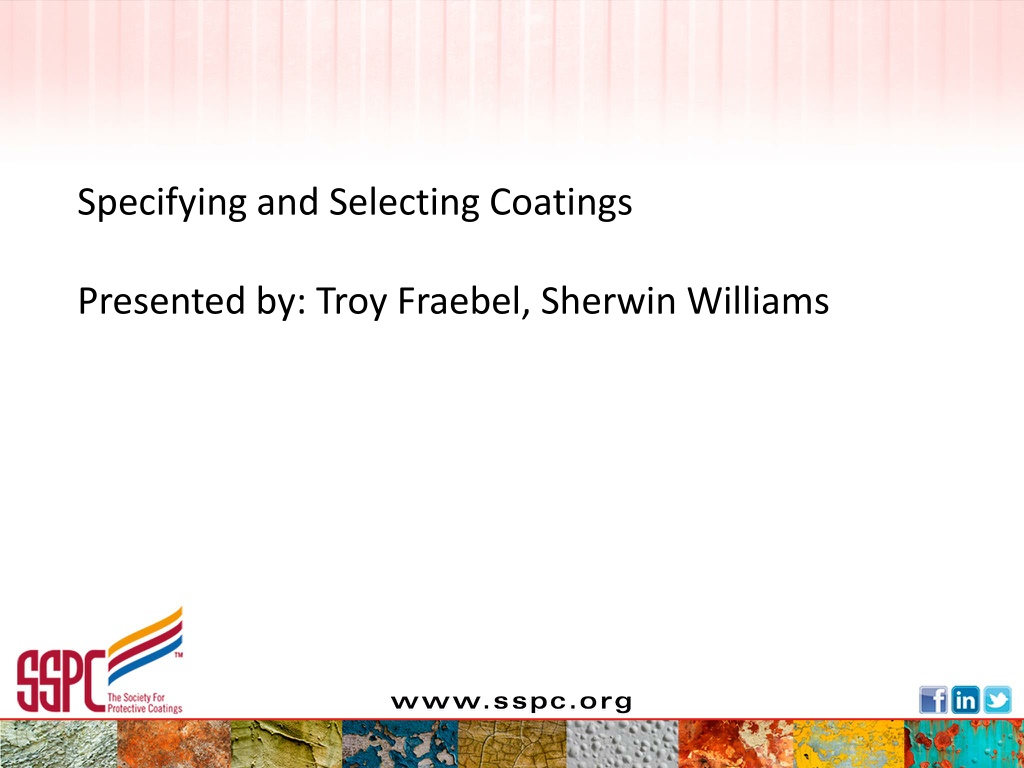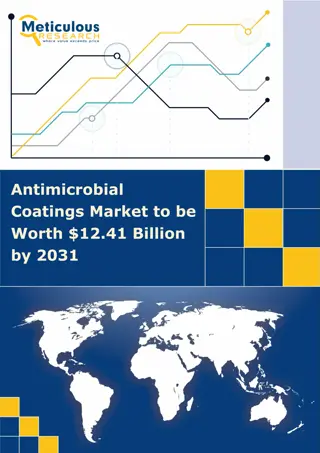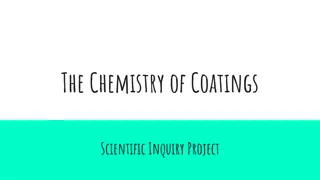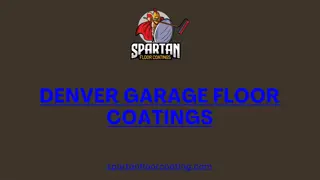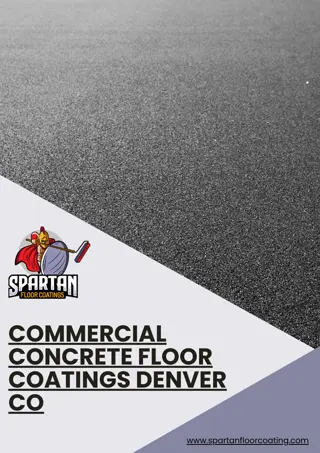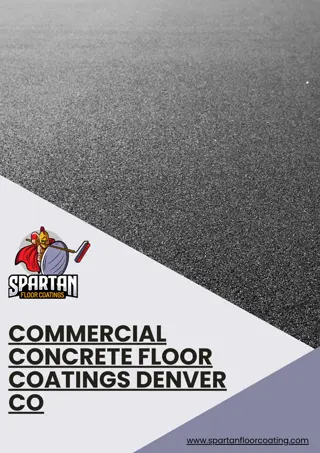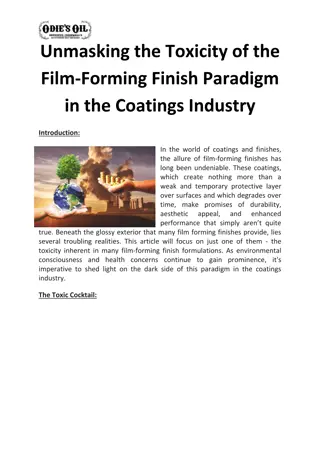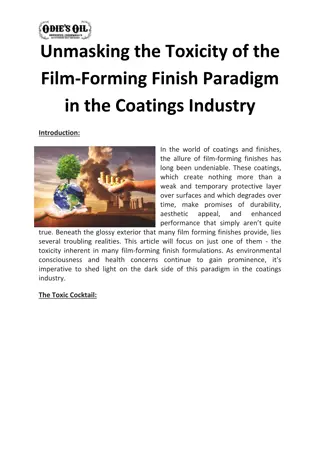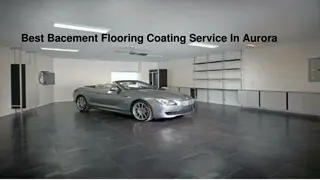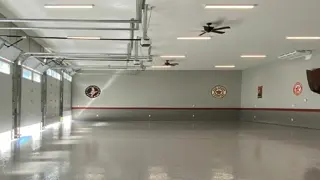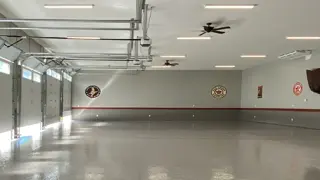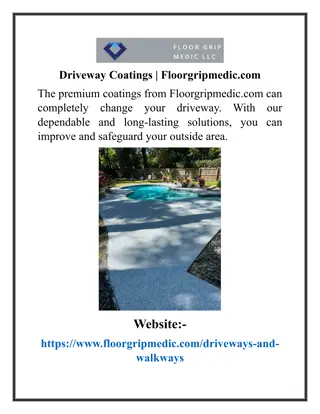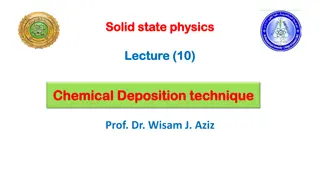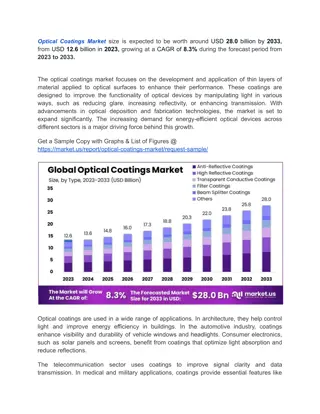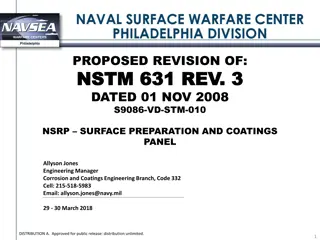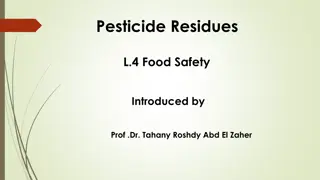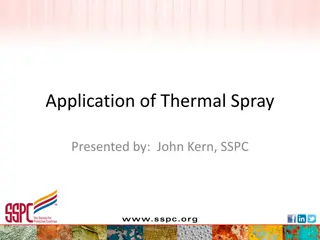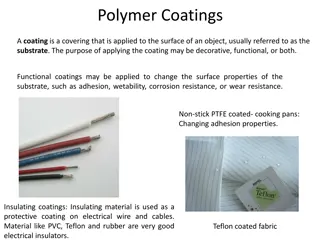Guide to Selecting and Specifying Coatings for Various Substrates
This guide covers the process of specifying and selecting coatings for different substrates, structures, and environments. It includes information on painting project specifications, writing clear and concise specifications, important word meanings, coating specification formats, and factors to consider in coating system selection.
Download Presentation

Please find below an Image/Link to download the presentation.
The content on the website is provided AS IS for your information and personal use only. It may not be sold, licensed, or shared on other websites without obtaining consent from the author. Download presentation by click this link. If you encounter any issues during the download, it is possible that the publisher has removed the file from their server.
E N D
Presentation Transcript
Specifying and Selecting Coatings Presented by: Troy Fraebel, Sherwin Williams
Introduction This webinar will provide guidance on how to properly specify and select a coating system for a specific substrate (carbon steel, other metals, concrete, previously coated), structure, and environment.
Painting Project Specification A statement of particulars, describing the dimensions, details, or peculiarities of any work to be undertaken.. Legal document. Part of a contract. Provides the (technical) rules. Practical document. Requires thorough planning. What, where, when, but NOT so much on how!
Painting Project Specification Contents Scope of work. Areas to be coated and not coated. Site specific requirements. Paint materials and suppliers. Surface preparation, application, and inspection requirements using standard methods.
Specification Writing Goals Clear. Complete. Concise. Consistent. Correct.
Specification Writing Techniques Use short sentences. One requirement per sentence. Place action words at the beginning. Use strong verbs. Never repeat descriptions or requirements. Define words that may be misunderstood. Use the same writing style throughout.
Important Word Meanings Shall. Essential requirement. Should. Preference or strong recommendation. May. Used when alternatives are acceptable.
Coating Specification Formats Construction Specification Institute (CSI) SSPC modified CSI format Major Sections General Products Execution
Coating System Selection Coating mechanisms and types Type of substrate (steel, concrete, etc.) Prevailing service environment (immersion?) Level of surface preparation possible Access to the work Owner s desires and expectations: Intended service life of structure Desired service life of coating Worker skills and equipment availability Aesthetics (gloss & color retention) Timing Economics
Making Steel Corrode Anode Cathode Metallic Pathway Electrolyte
How Coatings Protect Surfaces Barrier Inhibitive Sacrificial Corrosion Prevention Stop the deterioration of a substrate. Corrosion is a natural process that displays the tendency of materials to give up energy and return to its natural state.
Zinc-Rich Primers Contain High Percentage of Zinc Dust in the Dried Film So That There Is Direct Contact Between Zinc Particles and Steel Sacrificial / Galvanic Protection (like galvanizing) Corrosion Protection Prevention of Undercutting
Solvent Based Epoxies Excellent Alkali, Solvent, and Water Resistance Good Abrasion Resistance Good Acid Resistance Good Exterior Durability but ... Low Temperature Application Available Typical Dry Heat Resistance to 250 F
Solvent Based Alkyds Application as low as 40 F Single Package / Ease of Application Heat Resistance to 200-250 F Embrittle With Age Prone to Yellow / Saponify Require modification for exterior topcoats
Waterborne Acrylics Single Component Water Based Fast dry and fast re-coat Good color and gloss retention Primers must contain inhibitors Low stress
Polyurethanes / Polyureas / Polyaspartics Aliphatic Excellent Color Retention Excellent Gloss Retention Primarily Used as Finish Coats More Expensive than Aromatics Aromatic Yellows & Chalks in Sunlight Yellows & Chalks in Bright Artificial Light Used as Primers & Intermediate Coat Less Expensive than Aliphatics
Moisture Cured Urethanes Can be surface tolerant Can be applied during high humidity Easy to application Fast cure / fast recoat Low temperature application to 20 F. Single component Reinforce with micaceous iron oxide Aliphatic topcoats
Types of Steel Cold-rolled Hot-rolled Stainless steel
Cold-Rolled Steel Typically steel coils; typically thin sheet steel. Produces a denser, smoother surface than hot-rolling. Phosphating may be used to promote coating adhesion; otherwise coatings may not bond well.
Hot-Rolled Steel Typical of structural steel used in construction. Manufacturing process creates a bonded layer of iron oxide called mill scale. Smooth Cathodic Differential expansion
Stainless Steel Better mechanical properties and greater resistance to corrosion than mild steel. Numerous grades of stainless steel (add chromium and . . . ) Harder than mild steel Prone to stress corrosion cracking (SCC)
Hot Dip Galvanized Surfaces Application of a zinc coating to steel by dipping it in molten zinc or by depositing zinc on the steel through electrolytic means. Post-treated with oil or a chromate conversion coating to protect from white rust, a wet-storage stain. Post-treatments must be removed before coating. Alkaline substrate. Oil-based alkyds may saponify.
Aluminum May require chemical treatment, wash priming, and/or brush off blasting with a soft abrasive. SSPC-SP 16
Ductile Iron Use Standard NAPF 500-03 Applying steel surface preparation specifications to ductile iron is inappropriate, and may actually result in damage to the pipe surface with subsequent reduced coating effectiveness and life expectancy.
Concrete A composite material comprised of a Portland cement and water mixture that serves as a binder for embedded particles of coarse and fine aggregate.
Concrete Characteristics Alkalinity (pH range of 9 to 12) Porosity Moisture Movement of concrete (i.e., cracking)
Concrete Types and Finishes Concrete (tilt-up, cast-in-place, block) Finish (broom, steel trowel, sacked, stoned, wood floated) Curing compounds / Sealers (paintable?)
Other Substrates Wood or plywood Polyvinyl Chloride (PVC) Fiberglass Reinforced Plastic (FRP)
Demands of Environments on Coating Systems
Questions to Ask Is the coating being applied to an interior or exterior space? What is the atmospheric service environment? Will the coating be exposed to abrasion and impact? What is the surface temperature once in service? Will there be a cleaning or cyclic exposure?
Questions to Ask Will the coating be immersed in chemicals? Type Concentration pH Temperature Primary or secondary containment What are the application conditions? Is the coating being applied in a climate- controlled shop environment or in the field? What is the surface temperature during application?
Interior Service Environment Coatings Coatings need not withstand sunny conditions. Maybe climate controlled.
Exterior Service Environment Coatings Designed to withstand sun, rain, and snow. Remain flexible after curing; won t crack or peel as it expands and contracts with changes in temperature and humidity. Additives enhance mildew-, fungus-, and UV-resistance.
Service Locations What are some different service locations? How might location affect the type of coating you would select? What factors should be considered?
Inland, Rural Free from the corrosive influence of airborne salt; polluted air and rain may still be present.
Heavy Industrial High corrosion rates High atmospheric chemical concentration (i.e., sulphur dioxide, nitrous oxide)
Marine High concentration of salt mist (chlorides). Not always in direct contact with salt spray or splashing waves. Often in conjunction with heavy industrial environments.
Immersion Better surface preparation. More impermeable. Typically not UV stable. Must resist constant exposure to the cargo.
Alternating Immersion Any area in which immersion in water is combined with period of exposure to the atmosphere just above it. Steel in a tidal range. High waterline in a tank.
Condensing Humidity Service Example: Headspace in a tank Indoor pool with condensation on ceiling Cold pipes
Chemical Environments Strong concentrations of highly corrosive gases, fumes, and chemicals that come in direct contact with the coated surface. Mild to severe; direct immersion or splash.
Underground Buried surfaces in direct contact with soil. Possibly highly acidic. Compatible with cathodic protection.
Abrasion and Impact Coatings exposed to particle objects that rub, scrape, impact, or erode the surface by friction (i.e., pipeline, dam gate).
Final Service Temperature Certain coatings are prone to limited chemical resistance and early failure when exposed to high in-service temperatures.
Other Factors to Consider What else might impact your choice of coating selection beyond the service environment?
Application Temperature Apply coating system only when the air and substrate temperature are within the range indicated by the manufacturer s written instructions on the product data sheet (PDS).
Coatings and Moisture Not applied to wet or damp surfaces unless formulated by the manufacturer for this type of application. Not applied on frosted or ice-coated surfaces. Typically not applied when surface temperature is less than 5oF (3oC) above the dew point.
Previously Coated Substrates Generic Type Assessment of Current Paint Percentage (%) of corrosion Adhesion to substrate and other coats Thickness (DFT) Number of coats Chalking, blistering, etc. Test Patch!
